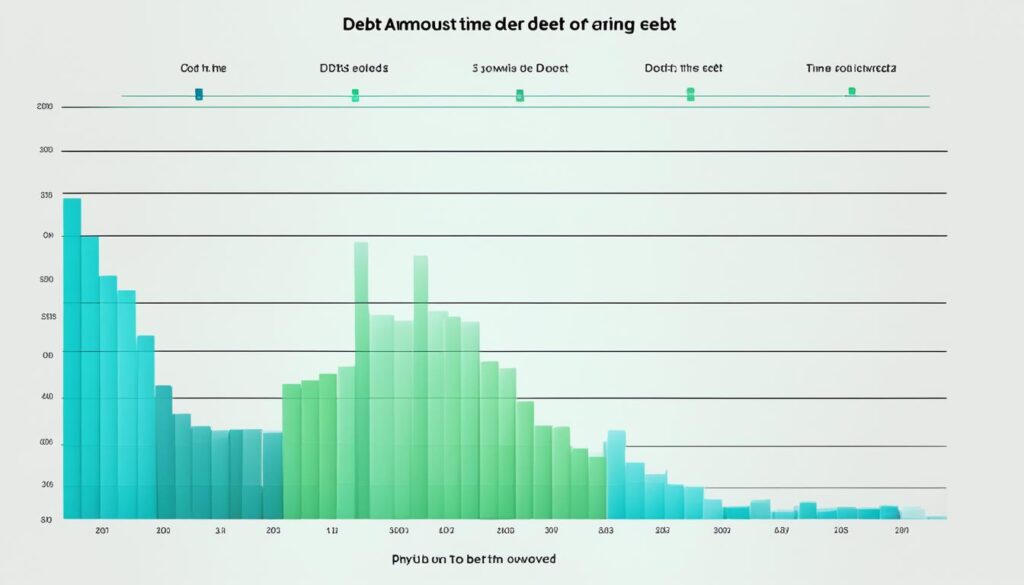Imagine this: you wake up one morning feeling a weight lifted off your shoulders. The sun shines a little brighter, and you feel a sense of freedom you haven’t experienced in years. Why? Because you’ve finally paid off your debt. It’s a moment of triumph, of accomplishment, and it’s within your reach.
But how do you get there? How do you create a roadmap to financial freedom that guides you through the maze of debt repayment? That’s where a debt repayment timeline comes in. By establishing a clear plan tailored to your specific circumstances, you can pave your way to a debt-free future.
Whether you’re trying to tackle credit card debt, student loans, or a mortgage, having a debt repayment plan is crucial. It helps you stay on track, make progress, and ultimately achieve your goal of being free from the burden of debt.
Key Takeaways:
- Create a personalized debt repayment plan to manage and pay off your debts effectively.
- Prioritize your debts based on factors such as interest rates, balances, and repayment timelines.
- Understand the types of debt you have, such as revolving balances and installment loans.
- Organize your debts by listing them and gaining a clear picture of your financial obligations.
- Select a debt repayment strategy that aligns with your motivation and financial goals.
Understanding Your Debt
Before creating a debt repayment plan, it’s important to understand the types of debt you have. Debt can be categorized into different types, such as revolving balance and installment loans. Let’s take a closer look at these debt types and how they can impact your financial journey.
Revolving Balance Debt
Revolving balance debt includes credit card debt, where you have a predetermined credit limit and make regular payments based on the outstanding balance. This type of debt often comes with varying interest rates, which can increase over time. It’s crucial to manage your credit card debt wisely, as high interest rates can lead to long-term financial challenges.
Installment Loans
Installment loans, on the other hand, are debts with fixed terms and regular payments. These can include mortgages, car loans, and student loans. Typically, installment loans have lower interest rates compared to revolving balance debt. However, the interest rates may still vary, so it’s important to consider the specific terms and conditions of each loan.
When prioritizing your debts for repayment, consider the balance owed, interest rates, and whether any debts are in collections. It’s essential to have a clear understanding of your debt types and their associated terms to make informed decisions when creating your debt repayment plan.
| Debt Type | Description | Interest Rate Range |
|---|---|---|
| Credit Card Debt | Debt with a credit card, based on a revolving balance | Varies (typically higher) |
| Mortgage | Loan for purchasing a property | Varies (typically lower) |
| Student Loan | Loan for educational expenses | Varies (typically lower) |
Image:
Organizing Your Debts
Creating an effective debt repayment plan begins with organizing your outstanding debts. By listing all your credit cards, student loans, car loans, and mortgages, you can gain a clear understanding of your financial obligations and prioritize them accordingly.
Creating a Debt List
Start by creating a comprehensive debt list that includes all your outstanding balances and the corresponding interest rates. This will help you visualize the extent of your debt and identify which debts require immediate attention.
| Debt Type | Outstanding Balance | Interest Rate |
|---|---|---|
| Credit Card 1 | $5,000 | 18% |
| Credit Card 2 | $3,000 | 20% |
| Student Loan | $15,000 | 5% |
| Car Loan | $10,000 | 7% |
| Mortgage | $200,000 | 4% |
Prioritizing Your Debts
Once you have your debt list, you can prioritize your debts based on several factors. Consider the interest rates, starting with the highest, as tackling high-interest debts first can save you money over time.
“Paying off debts with higher interest rates first is a smart strategy to reduce the overall cost of your debt in the long run.” – Financial Expert
In addition to interest rates, prioritize debts with smaller balances or those in collections. By paying off smaller debts first, you’ll experience a sense of accomplishment and motivation to continue working towards your debt-free goal.
Visualizing Your Debt List
Creating a visual representation of your debt list can help you understand your financial situation at a glance. You can use a spreadsheet or a debt tracking app to create charts or graphs that illustrate the progress you’re making towards paying off your debts.
Visualizing your debt list can serve as a powerful reminder of your financial goals and motivate you to stay focused on your debt repayment plan.
Prioritizing Your Debts
Prioritizing your debts is a crucial step in creating an effective debt repayment plan. By carefully considering factors such as interest rates, balance owed, and the timeline for repayment, you can strategically manage your debts and make progress towards becoming debt-free sooner. Let’s explore how to prioritize your debts and make informed decisions:
Consider Interest Rates
One key factor to consider when prioritizing your debts is the interest rate associated with each debt. Higher interest rates can significantly impact the overall cost of your debt over time. It’s generally advisable to prioritize debts with higher interest rates, as paying them off first can save you money in the long run.
Take Balance Owed into Account
Another important consideration is the amount of balance owed on each debt. While interest rates are crucial, debts with larger balances may also require attention. Balances owed on credit cards, loans, or mortgages will vary, and it’s essential to evaluate which debts have the greatest impact on your overall financial health.
Assess Debt Repayment Timeline
The timeline for debt repayment is another aspect to consider. Some debts may have specific repayment deadlines or fixed terms, while others may be more flexible. Evaluating the repayment timeline can help you prioritize debts that require your immediate attention and give you a clear plan for tackling each debt.
Consider Debt Priority
In addition to interest rates, balance owed, and repayment timeline, you should also consider the priority of each debt. Debts that are in collections or have severe consequences for non-payment should be dealt with promptly. By addressing these high-priority debts, you can protect your credit score and financial future.
Remember to take your overall income and monthly budget into account when prioritizing your debts. It’s crucial to set realistic goals based on your financial circumstances. If you’re struggling with the prioritization process, seeking advice from a financial advisor may provide additional guidance.

By prioritizing your debts based on interest rates, balance owed, debt repayment timeline, and debt priority, you can create a clear roadmap towards debt freedom. Developing a strategic plan that addresses your most pressing debts first will help you gain control over your financial situation while saving on interest and building a foundation for a stronger financial future.
Debt Repayment Strategies
Once you have prioritized your debts, it’s time to select a repayment strategy. This step is crucial in staying motivated and on track towards achieving your financial goals. Let’s explore three popular debt repayment strategies: the snowball method, the avalanche method, and the reverse snowball method.
The Snowball Method
The snowball method involves paying off your debts starting with the smallest balance first, regardless of interest rates. By focusing on eliminating smaller debts early on, you’ll experience a sense of accomplishment and momentum, keeping you motivated throughout your repayment journey. As you pay off each debt, you can direct the freed-up funds towards tackling larger debts. Eventually, you’ll build a snowball effect, gaining more confidence and financial traction as you progress.
The Avalanche Method
The avalanche method takes a different approach by prioritizing debts with the highest interest rates. Starting with the debt that carries the highest interest, you make larger payments to minimize the overall interest paid over time. While it may take longer to pay off larger debts, this strategy leads to substantial interest savings in the long run. If you are motivated by the prospect of minimizing interest costs, the avalanche method may be the right choice for you.
The Reverse Snowball Method
The reverse snowball method, also known as the ‘debt avalanche,’ focuses on prioritizing debts with the largest balances. By tackling higher balance debts first, you can make significant progress towards reducing your overall debt load more quickly. This approach may be appealing if you prefer to eliminate bigger debts sooner, giving you a sense of relief and opening up additional cash flow for other financial goals.
Remember, the key to debt repayment is finding a strategy that aligns with your motivation and financial goals. Whether you choose the snowball method, the avalanche method, or the reverse snowball method, the most important thing is to consistently make your monthly payments and avoid accumulating new debt.
You can also combine elements of these strategies to create a custom repayment plan that works best for you. For example, you could start with the reverse snowball method to eliminate high-balance debts quickly, then switch to the snowball method to build momentum as you tackle smaller debts. The choice is yours, as long as it keeps you focused and motivated on your repayment journey.

By selecting a suitable repayment strategy and sticking to your plan, you’ll not only save on interest payments but also make significant progress towards achieving a debt-free future. Stay motivated, track your progress, and celebrate every milestone along the way. Remember, the journey to financial freedom starts with a well-executed debt repayment strategy.
What Are the Best Strategies for Achieving Debt Repayment and Financial Independence?
When it comes to achieving debt repayment and financial independence, a few strategies can make a significant difference. Creating a realistic budget, prioritizing high-interest debt, and increasing income through side hustles are all effective approaches. Additionally, seeking professional advice and support can also accelerate the journey toward debt repayment and financial independence.
Conclusion
Creating a well-structured debt payoff plan is crucial for achieving financial independence and securing a debt-free future. By understanding your debts, organizing them effectively, prioritizing them wisely, and selecting a suitable repayment strategy, you can make significant progress towards your goal of becoming debt-free.
It is important to consistently track your progress and stay accountable to your plan. Make extra payments whenever possible to expedite your debt repayment journey and reduce interest expenses. With determination and discipline, you can successfully navigate the challenges of debt repayment and pave the way for a brighter financial future.
Remember, successful debt repayment requires a proactive approach. By taking control of your finances, you can build a solid foundation for long-term financial stability. Say goodbye to the burden of debt and embrace the freedom and peace of mind that comes with a debt-free life.
FAQ
What is a debt repayment timeline?
A debt repayment timeline is a plan that outlines the specific steps and milestones you will take to pay off your debts in a timely manner.
Why is creating a debt repayment plan important?
Creating a debt repayment plan is crucial for successfully managing and paying off debt. It helps you stay organized, motivated, and focused on your financial goals.
How do I understand the types of debt I have?
Debt can be categorized as either a revolving balance (like credit card debt) or an installment loan (like a mortgage or student loan). Understanding the types of debt you have will help you prioritize and manage your repayments effectively.
How do I organize my debts?
Start by making a list of all your outstanding debts, including credit cards, student loans, car loans, and mortgages. This will provide a clear picture of your financial obligations and help you prioritize them accordingly.
How do I prioritize my debts?
When prioritizing your debts, consider factors such as interest rates, balance owed, and the timeline for repayment. You may want to focus on paying off debts with higher interest rates or those in collections first.
What are some debt repayment strategies?
There are several debt repayment strategies you can choose from, such as the snowball method (paying off the smallest balance first), the avalanche method (paying off the debt with the highest interest rate first), or the reverse snowball method (starting with the largest balance). You can also customize a strategy that suits your specific goals and motivation.
How do I achieve financial freedom through debt repayment?
By creating a debt repayment plan, organizing your debts, prioritizing effectively, and following a repayment strategy, you can make significant progress towards becoming debt-free and achieving financial freedom.

